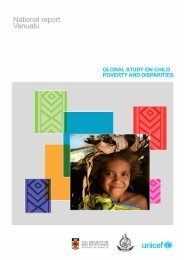A Strategic Assessment of the Children's Services Industry
A Strategic Assessment of the Children's Services Industry
A Strategic Assessment of the Children's Services Industry
- No tags were found...
Create successful ePaper yourself
Turn your PDF publications into a flip-book with our unique Google optimized e-Paper software.
STRATEGIC ASSESSMENT OF THE CHILDREN’S SERVICES INDUSTRYReview and analysis <strong>of</strong> supply and demand dataOne <strong>of</strong> <strong>the</strong> factors currently limiting child and family-focused decision making around earlychildhood services is <strong>the</strong> paucity <strong>of</strong> rich, accurate data on supply and demand. In this sectionwe briefly review <strong>the</strong> strengths and limitations <strong>of</strong> existing sources and outline <strong>the</strong> need forricher, more fine-grained information about supply and demand.As outlined in earlier sections <strong>of</strong> this report, an increasing proportion <strong>of</strong> Australian familiesmake use <strong>of</strong> child care. The proportion <strong>of</strong> 0-4 year old children using formal child care hasgrown from 24 per cent in March 1996 to 35 per cent in June 2005 (ABS, 2006: 44). Over thistime period, women’s overall labour force participation has increased from 54 per cent inMarch 1996 to 57 per cent in June 2005. (The current rate is 58.4 per cent) (ABS, 2008a).Almost half <strong>the</strong> mo<strong>the</strong>rs <strong>of</strong> children aged 0-4 years are in paid employment (David<strong>of</strong>f, 2007).The female labour force participation rate varies across Australia: it is lowest in Tasmania(55.4 per cent) and highest in Nor<strong>the</strong>rn Territory (68.1 per cent) as shown in Figure 5.1.Figure 5.1: Female Labour Force Participation Rate, Original, per centSource: Australian Bureau <strong>of</strong> Statistics (2008) catalogue 6291.0.55.001.Despite <strong>the</strong> growth <strong>of</strong> women’s labour force participation since <strong>the</strong> 1960s, Australian mo<strong>the</strong>rshave lower rates <strong>of</strong> labour force participation than <strong>the</strong>ir counterparts in many similarcountries. Women in <strong>the</strong> UK, USA, Germany, France, and Canada all have higher levels <strong>of</strong>labour force participation. Jaumotte argues that <strong>the</strong> determinants <strong>of</strong> women’s labour marketparticipation include <strong>the</strong> availability <strong>of</strong> paid parental leave, flexibility <strong>of</strong> working-timearrangements, <strong>the</strong> taxation second earners, child care subsidies and child benefits. Australiaranks seventeenth out <strong>of</strong> <strong>the</strong> twenty OECD countries in its support for working mo<strong>the</strong>rs(Jaumotte 2004).Parental labour force participation rates have a complex relation to <strong>the</strong> demand for earlychildhood services. Parents use many combinations <strong>of</strong> care and education arrangements for<strong>the</strong>ir children depending on <strong>the</strong>ir family needs (Willer, et al., 1991, SCRGSP, 2008). Parentsusing Commonwealth supported children’s services overwhelmingly cite ‘work-related’42
















